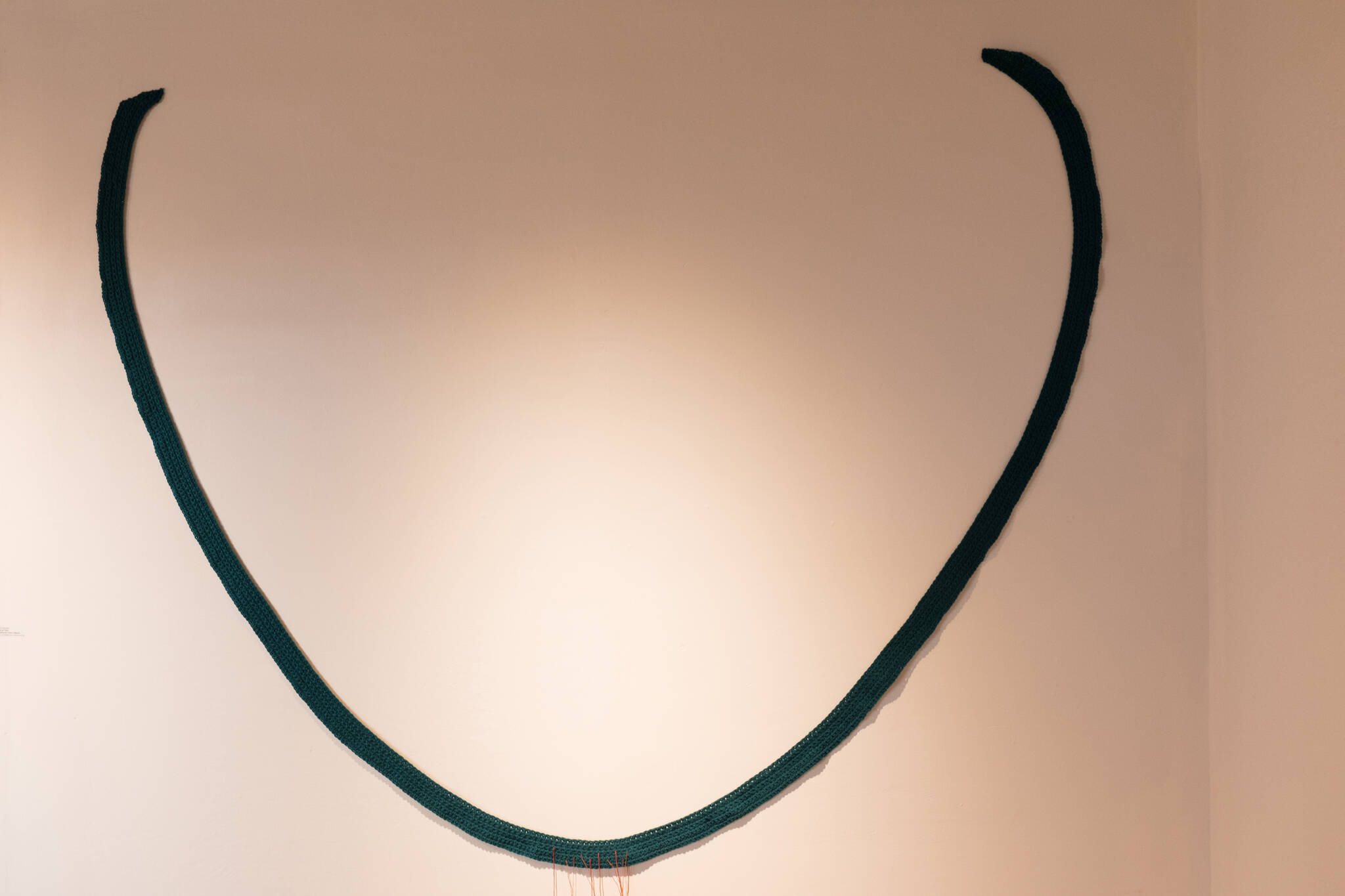By Sean McDermott
Special to the Homer News
Sunlight streamed through the front windows of the Bunnell Street Arts Center last week as visiting Swedish artist Berith Stennabb sat in stockinged feet, crocheting with the blue and yellow of the Ukrainian flag. She was making something soft for such a tough time, Stennabb said.
When Stennabb arrived in Homer in February, she thought she might use old materials from the fishing industry in her evolving art installation at Bunnell. But given her adaptive approach, when a Homer resident brought in dozens of skeins of yarn, Stennabb’s vision shifted.
An artist who often blends choreography with textile and fiber designs, Stennabb is in Homer as part of a two-month-long artist in residency exchange with the Konstmuseet, Skövde Kulturhus in Skövde, Sweden. Local Homer artist Mandy Bernard, who also works predominantly with textile and fiber, spent November and December 2021 in Skövde.
Asia Freeman, the artistic director of Bunnell Street Arts Center, said the idea for the exchange started in 2018, when two Swedish curators reached out about inviting an Alaska artist to their museum in Sweden.
“I found it interesting that they stated their interest in residencies for places where democracy is imperiled,” Freeman said.
When the curators visited Alaska to meet potential candidates and see their artwork, the conversation grew to include bringing Swedish artists for a residency in Homer as well, Freeman said.
Plans solidified for Bernard’s Swedish residency early in 2020, with Stennabb selected to be her local host and peer artist in Skövde — and then the COVID-19 pandemic put life on pause. Rather than let the opportunity disappear completely, however, the Skövde Museum sponsored a long-distance art exchange between Bernard and Stennabb.
The two artists set up a joint Instagram account and exchanged artwork by mail, sharing stories and getting to know each other. Bernard sent a crocheted net as a reflection of Homer’s ties to the sea, she said, and of her own time working repairing fishing nets.
When they finally met and began collaborating in Skövde in 2021, “we sort of centered on thinking about a net or a web,” Bernard said, approaching the theme from different angles.
“A lot of our work in textiles, there’s an element of pattern and repetition,” Bernard added. “When you’re crocheting something, you’re tying these knots over and over and over. And the same when you’re making a net — it’s just a series of knots, a pattern that creates something else.”
Bernard explained much of her current textile work is in the style of tufting, which is a technique involving cutting and looping fiber through a fabric base. Her residency in Sweden, where she was collaborating in a new, and more public space, helped Bernard step outside her normal artistic process.
“Much of what (Stennabb) does is improvisation and free moving and flow(ing) — and a lot of what I do is very rigid and precise,” Bernard said. “I think that the experience has shaken me out of that.”
Stennabb often incorporates movement and videography into her textile artworks, so one of the things the two artists did together was film their hands as they silently folded a garment that Stennabb created.
“It was such a simple thing,” Bernard said. “It was becoming something new — it wasn’t just a shirt that was wearable, it looked like an origami piece.”
That interaction sparked a project that Stennabb is continuing now during her residency at Bunnell. She is inviting locals to bring in a textile — a piece of cloth or garment — and to share the stories it holds for them as she films their hands folding and unfolding it together.
“If we talk about something that brings up memories, you could also see this in our hands,” Stennabb said.
Whether it is a dance performance, the simple act of folding or the long hours that she and Bernard spent unraveling wool donated by a women’s weaving collective during their time together in Sweden, Stennabb said she is fascinated by everyday motions.
In Homer, she has focused on creating a space that feels welcoming and inclusive, even letting visitors add to, and interact with her artwork.
“It’s not mine. It’s ours to share,” Stennabb said.
Her openness to change also serves as a source of inspiration. In Alaska, Stennabb has used the landscape, walks on the beach and local stories to help shape her art. One piece was inspired in part by the shape of oil containment booms in images of the Exxon Valdez oil spill that Stennabb saw at the Pratt Museum. At first, Stennabb titled the work “Lost at Sea,” but added a second title after overhearing a child’s reaction: “Wishbone with a Beard.”
“I don’t think that I will ever tell someone how to feel or how to react,” Stennabb said.
Before her residency at Bunnell, Stennabb said she was feeling a bit stuck, wondering where to go next with her work, but said she’s excited to bring the unfolding practice home with her.
In addition to Bernard and Stennabb, Anchorage-based Ahtna and Paiute artist Melissa Shaginoff also participated in the residency exchange, and Bunnell is looking forward to hosting Swedish artist Dano Willhelmsson this summer.
Freeman said residencies can be valuable for artists because they provide the time and space to grow and explore ideas in a new community, and that her take on Stennabb’s interactive work at Bunnell is that change is an essential component.
“What Berith is doing is really informed by this particular time that we’re living in from pandemic to the war in Ukraine,” Freeman said, “where both the threads of connection are more vulnerable and more important right now.”
“Artists are sensitive to world events, and they tend literally to weave them in.”
Sean McDermott is a freelance writer living in Homer.



